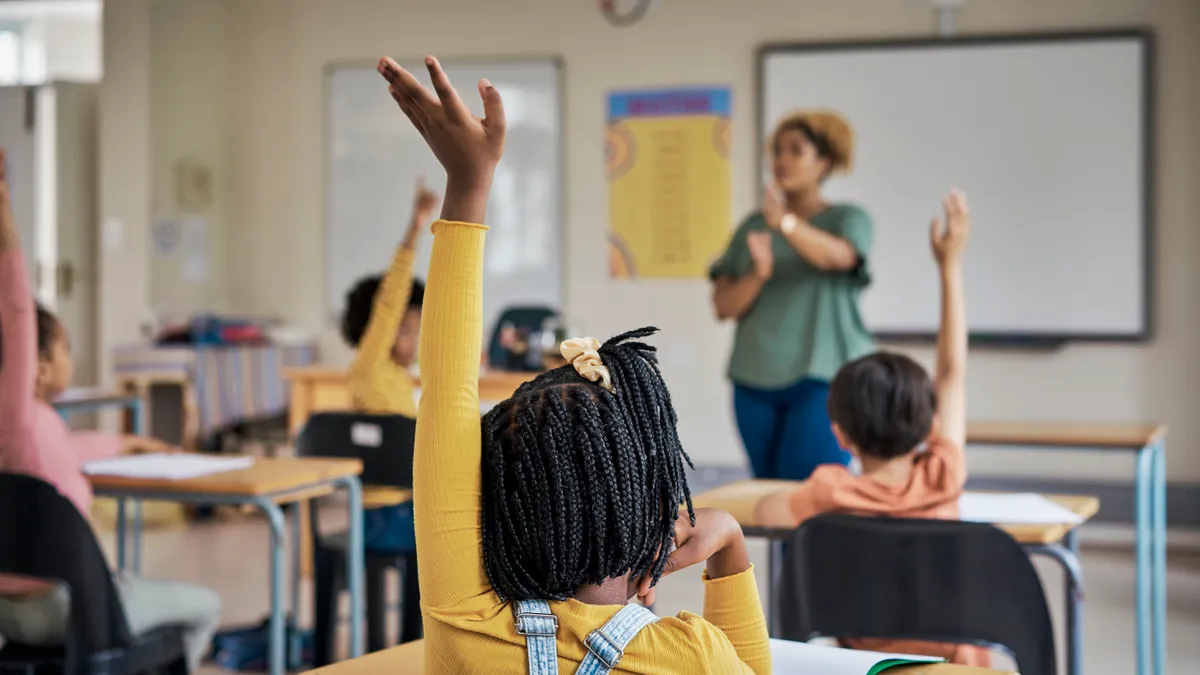Four and a half years ago, the COVID-19 pandemic upended K-12 school operations, causing learning to shift from in-person to online. Many educators correctly predicted that the hardships spurred by the public health emergency would set students back academically and socially. As it turned out, students from marginalized subgroups have fallen even further behind.
Even though Congress allocated an unprecedented $189.5 billion in one-time funding for school districts to spend on recovery from pandemic setbacks and expenses, that funding is ending even as some say more money is needed to continue catching students up to pre-pandemic learning growth.
Today — Sept. 30 — is the last day school districts can obligate, or promise to spend, American Rescue Plan funds, which is the last and largest allocation available through the Elementary and Secondary School Emergency Relief aid package.
Together, all three ESSER funding tranches equal about $1,000 per student annually, on average, for the past five school years. Some districts have prepared well for a funding off-ramp. But others, including some districts in high-poverty areas, may struggle to adjust to a non-ESSER reality.
“I think it’s important that we stress how huge, how impactful, this amount of money really is and continues to be,” Jasmine Bolton, policy director at the Partnership for the Future of Learning, told K-12 Dive in August. The Partnership for the Future of Learning is a nonprofit network of over 800 education stakeholders across the education field that advocates for equitable and high-quality schools.
What is significant about today?
After today, school districts will no longer be able to enter into new fiscal contracts or spending commitments using ARP funds. Schools also can’t pay their own employees with ESSER funds beyond Sept. 30. However, spending for vendor contracts for services or materials can stretch past the obligation deadline due to education finance provisions that existed before ESSER.
Explaining ESSER
What — The Elementary and Secondary School Emergency Relief fund combines three allocations approved by Congress in 2020 and 2021, known as ESSER I (CARES), II (CRRSA) and III (ARP).
How Much — ESSER's pre-K-12 funding adds up to $189.5 billion. The ESSER I allocation is $13.2 billion. ESSER II totals $54.3 billion, and ESSER III is the largest pandemic education assistance package at $121.9 billion.
When — Obligation deadlines set by Congress differ for each of the ESSER allocations. For ESSER I, schools must commit to spending projects by Sept. 30, 2022. For ESSER II, the deadline is Sept. 30, 2023, and for ESSER III, it's Sept. 30, 2024. The funds must be liquidated — or spent — within 120 calendar days after those dates. The U.S. Department of Education, however, is allowing spending extensions for districts for each of the ESSER allocations based on "specific facts and circumstances."
What happens after today?
The next date to watch for is Jan. 28, 2025. That's the spending deadline for ARP, when all funds must be liquidated. Nationally, the pace of spending for the three ESSER allocations has run as expected, according to education finance experts.
ESSER allocations under the Coronavirus Aid, Relief, and Economic Security Act and the Coronavirus Response and Relief Supplemental Appropriations Act had earlier obligation and spending deadlines. However, some districts that received spending extensions have longer spending time frames.
Updated information from the U.S. Department of Education, which is coordinating the COVID emergency funding for K-12 and higher education, shows that local school systems in four states — Delaware, Kansas, Kentucky, Nebraska — as well as Puerto Rico received approvals to extend about $1 billion collectively in ESSER-ARP spending for an extra 14 months through March 30, 2026.
Federal COVID emergency money left unspent by districts and states will eventually be returned to the Education Department.
K-12 federal COVID-19 relief fund spending extensions
How was the money spent?
Spending priorities for school districts shifted as the pandemic evolved and as districts assessed their changing needs.
ESSER funds spent through the CARES Act, the first federal emergency allocation totaling $30.75 billion, were mainly prioritized for helping schools to reopen safely for in-person learning when they could and continuing support for remote learning when necessary.
In the first year of the pandemic, schools rushed to provide all students with computers and WiFi access so they could log into remote classes. Then, as schools readied to reopen, they invested in air filtration systems and social distancing strategies such as scheduling more bus routes to keep ridership at lower capacities.
While CARES Act funds also paid for learning initiatives like tutoring, after school and summer programs, districts honed in on these practices using the two ESSER allocations from CRRSA and ARP.
ESSER-CRRSA dedicated $54.3 billion and ESSER-ARP $121.9 billion for school districts. Aside from the requirement that districts had to use at least 20% of their ESSER-ARP funds to address lost learning time for students, school systems had a lot of flexibility to invest in what they determined to be local priorities.
Staffing was also a top-of-mind investment for COVID aid. According to a February Center on Budget and Policy Priorities report based on state data, nearly 50% of ARP funds went toward labor costs, such as hiring of teachers, administrators, reading specialists and other staff, as well as for salary increases.
Districts made ESSER budgeting decisions in collaboration with staff, parents and their larger school communities.
"We focused on making a lasting difference in teaching and learning by addressing learning loss, upgrading facilities for safer in-person learning, and enhancing student and staff well-being,” said Angie Rushing, Tennessee's Weakley County Schools grants and special projects director and ESSER coordinator, in a Sept. 24 statement reflecting on ESSER's impact.
Was the funding effective?
To answer this question, school administrators and education finance experts recommend that districts dig into whether they achieved the intended goals of specific investments. For example, if a district dedicated money to boost in-person attendance and engagement, the district should be able to measure if attendance and engagement indeed improved.
Otherwise, it's too hard to generalize ESSER's return on investment, according to survey results released earlier this month by AASA, The School Superintendents Association.
AASA suggested researchers and policymakers help the K-12 education field develop measurements that could reveal pandemic relief spending best practices. “When evaluating the success of ARP there is still much to learn,” the report said.
Local administrators, however, will point out times over the past four years when their COVID funding — whether for facility upgrades, hiring staff to support students academically and socially, or staff wellness activities — brought positive results.
Meanwhile, Education Department officials report no signs of widespread fraud, waste or abuse in looking at the collective COVID emergency allocations for K-12.
All states, the District of Columbia and Puerto Rico have complied with ARP's maintenance of efforts requirements to keep state education funding at proportionate levels compared to pre-pandemic years, according to the Education Department. Only Alaska and North Dakota have been cited by the Education Department for not complying with a maintenance of equity requirement that protects against disproportionate cuts to the budgets or staffing at high-poverty and high-need schools.
Additionally, the department's Office of Inspector General has opened several reviews and audits of district and state oversight and spending practices, and it has several more underway.
Will there be more pandemic relief for schools?
Since this one-time funding was meant to support schools' rapid response to pandemic-related setbacks, no one, including policymakers and education experts, is expecting Congress to create a new COVID-specific aid package for schools.
Rather, money needed to continue recovery efforts will have to come from local and state allocations and through federal annual appropriations. Still, school officials and education experts say there is much work left to be done.
Chronic absenteeism rates are improving, but about 9.4 million students or 19% of students nationwide were chronically absent during the 2023-24 school year, according to Rand and the Center on Reinventing Public Education, in a report published Sept. 3.
Chronic absenteeism stood at 15% in 2018 but jumped to 28% in 2022, according to the Return 2 Learn Tracker from the American Enterprise Institute. Chronic absenteeism is defined as when a student misses at least 10% of the school year, or about 18 days.
Several state assessment results show improving academic performance compared to the early years of the pandemic. Some research points to a connection between the infusion of federal COVID relief and improved academic performance.
However, according to CRPE research released Sept. 17, the average American student who attended school during the pandemic is less than halfway to a full academic recovery.
And students with disabilities, English learners, and students from low-income families whose academic performance traditionally lagged behind their peers have fallen even further behind because of pandemic hardships.
More discussion is needed about how the pandemic hurt vulnerable student populations and the targeted strategies that are needed to help them, said Robin Lake, CRPE director, during a press briefing ahead of the report's release.
“I think that’s a really needed conversation,” Lake said.
Editor's Note: This story has been updated to include a table detailing federal COVID-19 relief spending extensions in K-12.





















